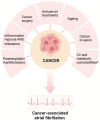Current Data and Future Perspectives on Patients with Atrial Fibrillation and Cancer
- PMID: 38001617
- PMCID: PMC10670853
- DOI: 10.3390/cancers15225357
Current Data and Future Perspectives on Patients with Atrial Fibrillation and Cancer
Abstract
Atrial fibrillation (AF) is an increasingly recognized comorbidity in patients with cancer. Indeed, cancer patients have a significantly higher incidence of AF than that observed in the general population. A reciprocal relationship between these two diseases has been observed, as much as some assume AF to be a marker for occult cancer screening, especially in older adults. The pathophysiological mechanisms are many and varied, including the underlying pro-inflammatory state, specific treatments (chemo- and radiotherapy), and surgery. The therapeutic management of patients with cancer and AF involves the same rhythm and frequency control strategies as the general population; however, the numerous interactions with chemotherapeutics, which lead to a significant increase in side effects, as well as the extreme fragility of the patient, should be considered. Anticoagulant therapy is also a complex challenge to address, as bleeding and stroke risk scores have not been fully assessed in this subpopulation. Furthermore, in large studies establishing the efficacy of direct oral anticoagulants (DOACs), cancer patients have been underrepresented. In this review, we elaborate on the mechanisms linking AF to cancer patients with a particular focus on the therapeutic challenges in this population.
Keywords: anticoagulation; atrial fibrillation; cancer.
Conflict of interest statement
The authors declare no conflict of interest.
Figures


References
-
- Lyon A.R., López-Fernández T., Couch L.S., Asteggiano R., Aznar M.C., Bergler-Klein J., Boriani G., Cardinale D., Cordoba R., Cosyns B., et al. 2022 ESC Guidelines on cardio-oncology developed in collaboration with the European Hematology Association (EHA), the European Society for Therapeutic Radiology and Oncology (ESTRO) and the International Cardio-Oncology Society (IC-OS) Eur. Heart J. 2022;43:4229–4361. doi: 10.1093/eurheartj/ehac244. - DOI - PubMed
-
- O’Neal W.T., Lakoski S.G., Qureshi W., Judd S.E., Howard G., Howard V.J., Cushman M., Soliman E.Z. Relation between cancer and atrial fibrillation (from the REasons for Geographic and Racial Differences in Stroke Study) Am. J. Cardiol. 2015;115:1090–1094. doi: 10.1016/j.amjcard.2015.01.540. - DOI - PMC - PubMed
Publication types
LinkOut - more resources
Full Text Sources

